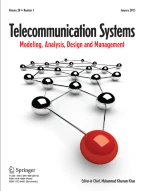Abstract
The proliferation of multimedia devices and user-generated content has driven a massive growth in Internet traffic for video streaming. There is a dire need to propose such solutions that can address multimedia streaming issues to achieve a user’s quality. Dynamic adaptive streaming over HTTP (DASH) improves the user’s quality through practical systems with limited bandwidth that enables the streaming media to run smoothly. This modern technology makes it easy to improve user perception and define the media presentation description (MPD) in terms of Uniform Resource Locator, content file, etc. The proposed adaptation algorithm attempts to determine the optimal solution to alleviate the conflict between maximizing the video quality and avoiding buffer stalls. We evaluate the proposed algorithm against alternative solutions such as ALDASH and FDASH for video content by taking into account the video bitrate, buffer level, and video bitrate switches for the single-user environment. A set of experiments have been conducted to investigate and analyze the benefits of our proposed algorithm. Our proposed algorithm is tested using the NS-3 network simulator, which shows that it improves video quality performance when compared to ALDASH and FDASH in terms of user satisfaction. Last but not least, the experimental results of our proposed algorithm provide high viewer quality in adaptive streaming as compared to its compititors.
Similar content being viewed by others
Explore related subjects
Discover the latest articles, news and stories from top researchers in related subjects.Data availability
Not applicable.
Code availability
At this stage, we can not provide the code because we are extending our project.
Notes
A User Study of Netflix Streaming.
References
Forecast, G. M. D. T. (2019). Cisco visual networking index: Global mobile data traffic forecast update, 2017–2022. Update, 2017, 2022.
Shafi, R., Shuai, W., & Younus, M. U. (2020). 360-degree video streaming: A survey of the state of the art. Symmetry, 12(9), 1491.
Sandvine, I. (2014). Global internet phenomena report: 1H. Report/
Index, C. V. N. (2017). Forecast and methodology, 2016–2021. White paper.
Pantos, R. (2010). Iphone HTTP live streaming: https://datatracker.ietf.org/doc/html/draft-pantos-http-live-streaming-05. Apple Inc., vol. 19, p. 22.
Stockhammer, T. (2011). Dynamic adaptive streaming over HTTP-- standards and design principles. In Proceedings of the second annual ACM conference on Multimedia systems (pp. 133-144).
Timmerer, C., & Müller, C. (2010). HTTP streaming of MPEG media. Streaming Day.
Shafi, R., Shuai, W., & Younus, M. U. (2020). MTC360: A multi-tiles configuration for viewport-dependent 360-degree video streaming. In 2020 IEEE 6th international conference on computer and communications (ICCC) (pp. 1868-1873). IEEE.
Lederer, S. (2015). Optimal adaptive streaming formats MPEG-DASH & HLS segment length. Bitmovin.
Van Der Hooft, J., Petrangeli, S., Wauters, T., Huysegems, R., Bostoen, T., & De Turck, F. (2018). An HTTP/2 push-based approach for low-latency live streaming with super-short segments. Journal of Network and Systems Management, 26(1), 51–78.
Nguyen, T. T., Vu, D. K., Phuong, V. T. L., Le, C., & Nguyen, Q. D. (2019). Performance of DASH over Multipath TCP. REV Journal on Electronics and Communications, 9(1-2).
Ayad, I., Im, Y., Keller, E., & Ha, S. (2018). A practical evaluation of rate adaptation algorithms in http-based adaptive streaming. Computer Networks, 133(3), 90–103.
Spiteri, K., Urgaonkar, R., & Sitaraman, R. K. (2020). BOLA: Near-optimal bitrate adaptation for online videos. IEEE/ACM Transactions on Networking, 28(4), 1698–1711.
Li, Z., Zhu, X., Gahm, J., Pan, R., Hu, H., Begen, A. C., & Oran, D. (2014). Probe and adapt: Rate adaptation for HTTP video streamzng at scale. IEEE Journal on Selected Areas in Communications, 32(4), 719–733.
Huang, T. Y., Johari, R., McKeown, N., Trunnell, M., & Watson, M. (2014, August). A buffer-based approach to rate adaptation: Evidence from a large video streaming service. In Proceedings of the 2014 ACM conference on SIGCOMM (pp. 187-198).
Nguyen, D. V., Tran, H. T., Pham, A. T., & Thang, T. C. (2017). A new adaptation approach for viewport-adaptive 360-degree video streaming. In 2017 IEEE International Symposium on Multimedia (ISM) (pp. 38-44). IEEE.
He, D., Westphal, C., & Garcia-Luna-Aceves, J. J. (2018). Joint rate and fov adaptation in immersive video streaming. In Proceedings of the 2018 Morning Workshop on Virtual Reality and Augmented Reality Network (pp. 27-32).
Yuan, H., Hu, X., Hou, J., Wei, X., & Kwong, S. (2019). An ensemble rate adaptation framework for dynamic adaptive streaming over HTTP. IEEE Transactions on Broadcasting, 66, 251–263.
Alqhtani, W. A., Taha, A. A., & Alsabaan, M. S. (2020). An adaptive quality switch-aware framework for optimal bitrate video streaming delivery. International Journal of Advanced Computer Science and Applications, 11(8), 1–10.
Vergados, D. J., Michalas, A., Sgora, A., Vergados, D. D., & Chatzimisios, P. (2015). FDASH: A fuzzy-based MPEG/DASH adaptation algorithm. IEEE Systems Journal, 10(2), 859–868.
Rahman, W. U., & Chung, K. (2017). A novel adaptive logic for dynamic adaptive streaming over HTTP. Journal of Visual Communication and Image Representation, 49, 433–446.
Chung, K. (2018). SABA: Segment and buffer aware rate adaptation algorithm for streaming over HTTP. Multimedia Systems, 24(5), 509–529.
Funding
Not applicable.
Author information
Authors and Affiliations
Contributions
The contributions of the authors are listed below: M.U. Younus: Conception, coding, experimentations, writeup and proof read. R. Shafi: Conception, experimentations and writeup. S.S Alshamrani: Proof read and reviewed the manuscript.
Corresponding author
Ethics declarations
Conflict of interest
The authors declare that there is no conflict of interest.
Additional information
Publisher's Note
Springer Nature remains neutral with regard to jurisdictional claims in published maps and institutional affiliations.
Rights and permissions
About this article
Cite this article
Younus, M.U., Shafi, R. & Alshamrani, S.S. A model for a practical evaluation of a DASH-based rate adaptive algorithm over HTTP. Telecommun Syst 81, 241–251 (2022). https://doi.org/10.1007/s11235-022-00931-0
Accepted:
Published:
Issue Date:
DOI: https://doi.org/10.1007/s11235-022-00931-0
